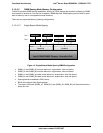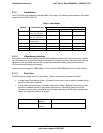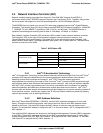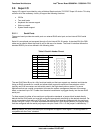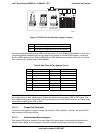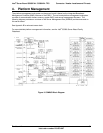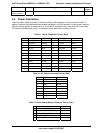
Intel
®
Server Board S5000PAL / S5000XAL TPS Functional Architecture
Revision 1.4
Intel order number: D31979-007
39
3.4 Network Interface Controller (NIC)
Network interface support is provided from the built in Dual GbE MAC features of the ESB-2 in
conjunction with the Intel
®
82563EB compact Physical Layer Transceiver (PHY). Together, they provide
the server board with support for dual LAN ports designed for 10/100/1000 Mbps operation.
The 82563EB device is based upon proven PHY technology integrated into the Intel
®
Gigabit Ethernet
Controllers. The physical layer circuitry provides a standard IEEE 802.3 Ethernet interface for 1000BASE-
T, 100BASE-TX, and 10BASE-T applications (802.3, 802.3u, and 802.3ab). The 82563EB device is
capable of transmitting and receiving data at rates of 1000 Mbps, 100 Mbps, or 10 Mbps
Each Network Interface Controller (NIC) drives two LEDs located on each network interface connector.
The link/activity LED (to the right of the connector) indicates network connection when on, and
Transmit/Receive activity when blinking. The speed LED (to the left of the connector) indicates 1000-
Mbps operation when amber, 100-Mbps operation when green, and 10-Mbps when off. The table below
provides an overview of the LEDs.
Table 7. NIC2 Status LED
LED Color LED State NIC State
Off 10 Mbps
Green 100 Mbps
Green/Amber (Left)
Amber 1000 Mbps
On Active Connection
Green (Right)
Blinking Transmit / Receive activity
3.4.1 Intel
®
I/O Acceleration Technology
Intel
®
I/O Acceleration Technology moves network data more efficiently through Dual-Core Intel
®
Xeon
®
processor 5000 sequence-based servers for improved application responsiveness across diverse
operating systems and virtualized environments. Intel
®
I/OAT improves network application
responsiveness by unleashing the power of Dual-Core Intel
®
Xeon
®
processors 5000 sequence through
more efficient network data movement and reduced system overhead. Intel multi-port network adapters
with Intel
®
I/OAT provide high-performance I/O for server consolidation and virtualization via stateless
network acceleration that seamlessly scales across multiple ports and virtual machines. Intel
®
I/OAT
provides safe and flexible network acceleration through tight integration into popular operating systems &
virtual machine monitors, avoiding the support risks of 3rd-party network stacks and preserving existing
network requirements such as teaming and failover.
3.4.2 MAC Address Definition
Each Intel
®
Server Board S5000PAL / S5000XAL has four MAC addresses assigned to it at the Intel
factory. During the manufacturing process, each server board will have a white MAC address sticker
placed on the board. The sticker will display the MAC address in both bar code and alpha numeric
formats. The printed MAC address is assigned to NIC 1 on the server board. NIC 2 is assigned the NIC 1
MAC address + 1.
Two additional MAC addresses are assigned to the Baseboard Management Controller (BMC) embedded
in the ESB-2. These MAC addresses are used by the BMC’s embedded network stack to enable IPMI
remote management over LAN. BMC LAN Channel 1 is assigned the NIC1 MAC address + 2, and BMC
LAN Channel 2 is assigned the NIC1 MAC address + 3.




